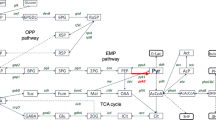Abstract.
In the absence of exogenous donors, turnover of 10 molar equivalents of H2O2 by wild-type recombinant cytochrome c peroxidase [CCP(MI)] and its W191F mutant at pH 7.0 occurs by oxidation of endogenous donors on the polypeptide. No O2 evolution was observed with either enzyme on reaction with 10 molar equivalents of H2O2, eliminating catalase-like activity \({\rm{(2H}}_{\rm{2}} {\rm{O}}_{\rm{2}} \buildrel {} \over \rightleftharpoons {\rm{O}}_{\rm{2}} + {\rm{2H}}_{\rm{2}} {\rm{O)}}\) , but O2 evolution was observed when 100 molar equivalents of H2O2 were added to the enzymes. Protein dimers were observed by SDS-PAGE following H2O2 turnover by the peroxidases, and dimeric forms of CCP(MI) and CCP(W191) were isolated by gel-permeation chromatography. LC-ESI-MS analysis of the tryptic digests of the dimers revealed the previously reported T6-T6 crosslink and a new crosslink between T6-T26, but no T26-T26 crosslink. The crosslinked tryptic peptides contain the exposed tyrosine residues Tyr36, Tyr39 and Tyr42 (T6), and Tyr229 and Tyr236 (T26). Addition of a spin trap, 2-methyl-2-nitrosopropane (MNP), to the CCP(MI)/H2O2 reaction resulted in MNP labeling of peptides T6, T21 (which contains Tyr153) and T26. MNP labeling of Tyr236 was found by sequencing peptide T26. MNP labeling did not compete with dimerization of H2O2-oxidized CCP(W191F), suggesting that dityrosine formation in this mutant is very rapid owing to the high reactivity of radicals formed on T6. H2O2-dependent formation of CCP-cytochrome c heterodimers was observed for both CCP(MI) and W191F in the presence of ferricytochrome c, the oxidized form of CCP's donor substrate. Interestingly, no H2O2-dependent cytochrome crosslinking to the W51F mutant was observed, even though this mutant underwent extensive homocrosslinking. The translocation of oxidizing equivalents from the heme to the surface residues of CCP is discussed in terms of an antioxidant role for CCP.
Similar content being viewed by others
Author information
Authors and Affiliations
Additional information
Electronic Publication
Rights and permissions
About this article
Cite this article
Tsaprailis, G., English, A.M. Different pathways of radical translocation in yeast cytochrome c peroxidase and its W191F mutant on reaction with H2O2 suggest an antioxidant role. J Biol Inorg Chem 8, 248–255 (2003). https://doi.org/10.1007/s00775-002-0407-6
Received:
Accepted:
Issue Date:
DOI: https://doi.org/10.1007/s00775-002-0407-6




